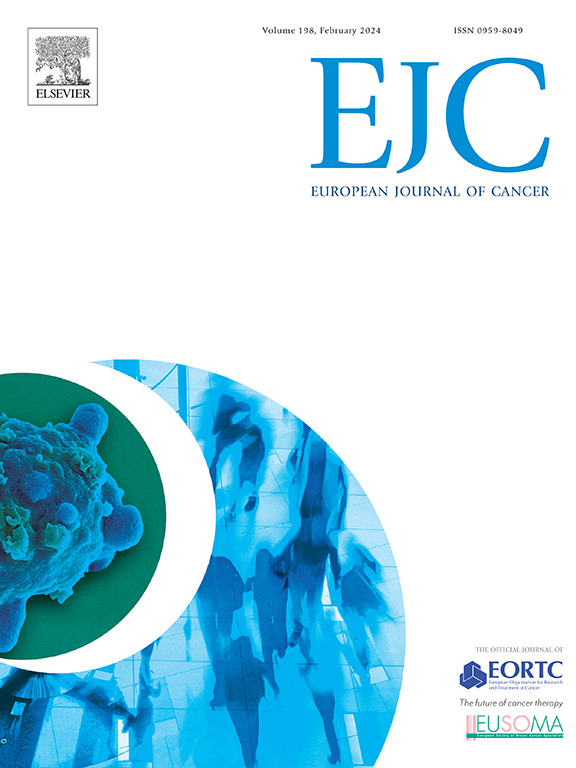Pembrolizumab with or without chemotherapy in recurrent or metastatic head and neck squamous cell carcinoma: 5-year follow-up from the randomized phase III KEYNOTE-048 study
IF 7.6
1区 医学
Q1 ONCOLOGY
引用次数: 0
Abstract
Background
Pembrolizumab monotherapy and pembrolizumab-chemotherapy demonstrated superior overall survival (OS) versus cetuximab-chemotherapy (EXTREME) in the primary analysis of the phase III KEYNOTE-048 study of recurrent/metastatic head and neck squamous cell carcinoma (R/M HNSCC) in the first-line setting. We report updated data with 5 years of follow-up.
Methods
Adults with previously untreated R/M HNSCC incurable by local therapy were randomly assigned 1:1:1 to pembrolizumab, pembrolizumab plus chemotherapy, or EXTREME. The primary endpoints were OS and progression-free survival (PFS).
Results
Overall, 882 participants were assigned to pembrolizumab, pembrolizumab-chemotherapy, or EXTREME. Median study follow-up was 69.2 months (pembrolizumab) and 68.6 months (pembrolizumab-chemotherapy). Median OS remained longer for pembrolizumab versus EXTREME in the programmed cell death ligand 1 (PD-L1) combined positive score (CPS) ≥ 20 (HR, 0.61; 95 % CI, 0.46–0.81) and CPS ≥ 1 populations (HR, 0.74; 95 % CI, 0.61–0.89), and similar in the total population (HR, 0.82; 95 % CI, 0.69–0.97). Pembrolizumab-chemotherapy prolonged median OS in the PD-L1 CPS ≥ 20 (HR, 0.63; 95 % CI, 0.47–0.84), CPS ≥ 1 (HR, 0.65; 95 % CI, 0.53–0.79), and total (HR, 0.72; 95 % CI, 0.60–0.86) populations. The 5-year OS rate in the total population was 14.4 % for pembrolizumab versus 6.5 % for EXTREME and 16.0 % for pembrolizumab-chemotherapy versus 5.2 % for EXTREME. There was no clinically meaningful difference in PFS among pembrolizumab, pembrolizumab-chemotherapy, or EXTREME groups in any populations.
Conclusions
These 5-year follow-up results support the use of pembrolizumab and pembrolizumab-chemotherapy as first-line standards of care for R/M HNSCC.
Clinical Trial Information
NCT02358031.
Prior Presentation
Presented at the European Society for Medical Oncology Congress, September 9–13, 2022.
Pembrolizumab联合或不联合化疗治疗复发或转移性头颈部鳞状细胞癌:来自随机III期KEYNOTE-048研究的5年随访
在一线复发/转移性头颈部鳞状细胞癌(R/M HNSCC)的III期KEYNOTE-048研究的初步分析中,派姆单抗单药治疗和派姆单抗化疗显示出优于西妥昔单抗化疗(EXTREME)的总生存期(OS)。我们报告了5年随访的最新数据。方法:既往未治疗的经局部治疗无法治愈的成人R/M HNSCC随机按1:1:1分配至派姆单抗组、派姆单抗联合化疗组或EXTREME组。主要终点为OS和无进展生存期(PFS)。总体而言,882名参与者被分配到派姆单抗、派姆单抗联合化疗或EXTREME组。中位研究随访为69.2个月(派姆单抗)和68.6个月(派姆单抗-化疗)。在程序性细胞死亡配体1 (PD-L1)联合阳性评分(CPS)≥ 20 (HR, 0.61;95 % CI, 0.46-0.81)和CPS≥ 1人群(HR, 0.74;95 % CI, 0.61-0.89),在总人口中相似(HR, 0.82;95 % ci, 0.69-0.97)。pembrolizumab化疗延长PD-L1 CPS≥ 20的中位OS (HR, 0.63;95 % ci, 0.47-0.84), CPS≥ 1 (hr, 0.65;95 % CI, 0.53-0.79)和total (HR, 0.72;95 % CI, 0.60-0.86)人群。总体人群的5年OS率,派姆单抗组为14.4 %,EXTREME组为6.5 %;派姆单抗联合化疗组为16.0 %,EXTREME组为5.2 %。在任何人群中,派姆单抗、派姆单抗联合化疗组或EXTREME组的PFS均无临床意义差异。这些5年随访结果支持使用派姆单抗和派姆单抗联合化疗作为R/M HNSCC的一线治疗标准。临床试验信息nct02358031。先前报告:于2022年9月9日至13日在欧洲肿瘤医学学会大会上发表。
本文章由计算机程序翻译,如有差异,请以英文原文为准。
求助全文
约1分钟内获得全文
求助全文
来源期刊

European Journal of Cancer
医学-肿瘤学
CiteScore
11.50
自引率
4.80%
发文量
953
审稿时长
23 days
期刊介绍:
The European Journal of Cancer (EJC) serves as a comprehensive platform integrating preclinical, digital, translational, and clinical research across the spectrum of cancer. From epidemiology, carcinogenesis, and biology to groundbreaking innovations in cancer treatment and patient care, the journal covers a wide array of topics. We publish original research, reviews, previews, editorial comments, and correspondence, fostering dialogue and advancement in the fight against cancer. Join us in our mission to drive progress and improve outcomes in cancer research and patient care.
 求助内容:
求助内容: 应助结果提醒方式:
应助结果提醒方式:


